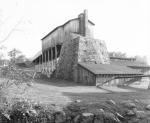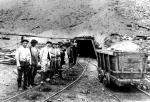![header=[Marker Text] body=[At nearby Curtin, making iron was begun about 1810 by Roland Curtin. The last old-style furnace in the U.S. was in blast here and ceased operation in 1922. ] sign](http://explorepahistory.com/kora/files/1/10/1-A-2B0-139-ExplorePAHistory-a0k1y9-a_450.jpg)
Mouse over for marker text
Name:
Eagle Ironworks
Region:
Valleys of the Susquehanna
County:
Centre
Marker Location:
Pa. 150 (former U.S. 220) 2.8 miles NE or Milesburg
Dedication Date:
April 29, 1947
Behind the Marker
Roland Curtin enjoyed a remarkable thirty-four-year career in the iron industry, expanding a small iron forge into a large iron plantation. Born in Ireland, Curtin settled in the Bald Eagle Valley of the Juniata iron region in 1797, when the area was first settled. In 1810 he and a partner constructed Eagle Forge along Bald Eagle Creek. They bought pig iron from area furnaces to be hammered into wrought iron at the refinery forge.
In 1818 Curtin bought out his partner and built the cold blast, charcoal Eagle Furnace to supply his forge. Although it had been thirty-three years since the first Juniata region furnace had gone into blast, and all the necessary raw materials were abundant in the area, expanding his iron works and constructing Eagle Furnace was a precarious business proposition.
As Curtin's great-grandson later recounted, "Everything required had to be transported on flat-boats . . . or on pack horses over mountain trails, roads cut thru forests, dams built, ore mined, wood chopped . . . and . . . converted into charcoal, waterwheels and blowing machinery for furnaces and forges constructed . . . before a pound of iron was made."
Curtin, however, was up to the task. Demand for iron expanded during the 1820s and early 1830s. With borrowed money and earnings from the furnace and forge, he constructed a rolling mill, bought more land, and built housing for workers, himself, and his older sons, whom he brought into the business.
At its peak in 1832, Curtin's iron plantation had more than sixty houses for about seventy-five employees and their families. Hundreds of acres of farmland provided food for workers and the horses, mules, and other livestock that hauled materials and iron around the plantation. He provided company-owned houses to the ironworkers, blacksmiths, wagon drivers, colliers and other employees who worked at the furnace, forge, and rolling mill, and owned the store that sold them their goods, unsually on credit. Other families lived as tenants on Curtin's many farms.
Roland Curtin and his sons sought a paternalistic relationship with employees. The Curtins lived among workers and intermingled with them frequently. Dependent upon the labor of workers, they saw themselves as surrogate parents of them and their families. When shutdowns came, the ironmaster made work for employees so that workers could continue earning livelihoods. Like other ironmasters, the Curtins also demanded deference. Workers addressed the ironmaster as "Mister Curtin," while the Curtins referred to villagers by their first names or nicknames. The ironmaster also decided what would be done by whom when, who would be hired or fired, and who would live in company housing. In addition, the Curtins resided in much grander "big houses," obviously superior to workers' cabins.
Workers had varied attitudes toward Roland Curtin and his sons. Some employees were quite loyal; generations of some families labored for the Curtins. Similar to workers at Hopewell Village, some employees named their sons after Roland Curtin, sought his advice, and asked him to be administrator of their estates or guardian of minor children, despite that fact that almost all workers were American-born of British or German ancestors, and some viewed Roland Curtin as an Irish-immigrant "foreigner."
Hopewell Village, some employees named their sons after Roland Curtin, sought his advice, and asked him to be administrator of their estates or guardian of minor children, despite that fact that almost all workers were American-born of British or German ancestors, and some viewed Roland Curtin as an Irish-immigrant "foreigner."
The Curtins' big houses, clothing, education, and demand for deference could also produce resentment among employees, some of whom left work to go on a spree, drink, or gamble at horse races, despite the ironmaster's desire for steadiness and sobriety.
By the time that Roland Curtin retired as the ironmaster of Eagle Ironworks in 1844, the expansion of the ironworks had caught up with him. Curtin had gone deeply into debt financing expansion or the works, and had to mortgage much of his property to avoid bankruptcy. After he died in 1850, it took his sons more than twenty years to restore the ironworks to solvency. Later on, the third and fourth generations of Curtins, still operating a cold-blast, charcoal iron furnace, could not compete with the new bituminous-coke furnaces and the rise of steel.
The Curtins' furnace and forge operated exceptionally long by supplying a small niche market for charcoal iron in the steel industry. But the furnace finally closed after a disastrous fire in 1921, and the forge went silent in 1922. Today, the Curtin Village at Eagle Ironworks is a state-owned historical site, and the remains of the plantation, including the 1830 mansion, a restored furnace, and a restored worker's cabin, are open to the public.
In 1818 Curtin bought out his partner and built the cold blast, charcoal Eagle Furnace to supply his forge. Although it had been thirty-three years since the first Juniata region furnace had gone into blast, and all the necessary raw materials were abundant in the area, expanding his iron works and constructing Eagle Furnace was a precarious business proposition.
As Curtin's great-grandson later recounted, "Everything required had to be transported on flat-boats . . . or on pack horses over mountain trails, roads cut thru forests, dams built, ore mined, wood chopped . . . and . . . converted into charcoal, waterwheels and blowing machinery for furnaces and forges constructed . . . before a pound of iron was made."
Curtin, however, was up to the task. Demand for iron expanded during the 1820s and early 1830s. With borrowed money and earnings from the furnace and forge, he constructed a rolling mill, bought more land, and built housing for workers, himself, and his older sons, whom he brought into the business.
At its peak in 1832, Curtin's iron plantation had more than sixty houses for about seventy-five employees and their families. Hundreds of acres of farmland provided food for workers and the horses, mules, and other livestock that hauled materials and iron around the plantation. He provided company-owned houses to the ironworkers, blacksmiths, wagon drivers, colliers and other employees who worked at the furnace, forge, and rolling mill, and owned the store that sold them their goods, unsually on credit. Other families lived as tenants on Curtin's many farms.
Roland Curtin and his sons sought a paternalistic relationship with employees. The Curtins lived among workers and intermingled with them frequently. Dependent upon the labor of workers, they saw themselves as surrogate parents of them and their families. When shutdowns came, the ironmaster made work for employees so that workers could continue earning livelihoods. Like other ironmasters, the Curtins also demanded deference. Workers addressed the ironmaster as "Mister Curtin," while the Curtins referred to villagers by their first names or nicknames. The ironmaster also decided what would be done by whom when, who would be hired or fired, and who would live in company housing. In addition, the Curtins resided in much grander "big houses," obviously superior to workers' cabins.
Workers had varied attitudes toward Roland Curtin and his sons. Some employees were quite loyal; generations of some families labored for the Curtins. Similar to workers at
The Curtins' big houses, clothing, education, and demand for deference could also produce resentment among employees, some of whom left work to go on a spree, drink, or gamble at horse races, despite the ironmaster's desire for steadiness and sobriety.
By the time that Roland Curtin retired as the ironmaster of Eagle Ironworks in 1844, the expansion of the ironworks had caught up with him. Curtin had gone deeply into debt financing expansion or the works, and had to mortgage much of his property to avoid bankruptcy. After he died in 1850, it took his sons more than twenty years to restore the ironworks to solvency. Later on, the third and fourth generations of Curtins, still operating a cold-blast, charcoal iron furnace, could not compete with the new bituminous-coke furnaces and the rise of steel.
The Curtins' furnace and forge operated exceptionally long by supplying a small niche market for charcoal iron in the steel industry. But the furnace finally closed after a disastrous fire in 1921, and the forge went silent in 1922. Today, the Curtin Village at Eagle Ironworks is a state-owned historical site, and the remains of the plantation, including the 1830 mansion, a restored furnace, and a restored worker's cabin, are open to the public.











